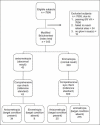Assessment of a modification of Brückner's test as a screening modality for anisometropia and strabismus
- PMID: 21120049
- PMCID: PMC2992160
- DOI: 10.4103/0974-620X.71890
Assessment of a modification of Brückner's test as a screening modality for anisometropia and strabismus
Abstract
Background: Current amblyopia screening methods are not cost effective.
Aim: To evaluate the diagnostic capability of a modified Brückner test (MBT) for amblyopiogenic risk factors.
Materials and methods: We applied the MBT using the streak retinoscope to identify anisometropia and strabismus by noting an inter-ocular difference in movement and glow, from children who failed 6/9 Snellen on community vision screening, followed by comprehensive eye examination. STATISITICS: Data were analyzed by 2 × 2 tables for diagnostic test parameters (95% CI).
Results: From 7998 children vision-screened, 392 failed 6/9 VA and were referred. Since 34 failed to reach the centers, and 15 were excluded due to poor/ no glow, data from 343 was analyzed. The prevalence of anisometropia of 0.5D was 17%, of 1D was 11% and of strabismus 5%. For the MBT the accuracy was ≥ 90% (95%CI 89% to 97%) over the three outcomes. The sensitivity, specificity, NPV and +LR for anisometropia of 0.5D were: 0.57 (0.48, 0.64), 0.97 (0.95, 0.98), 0.92 (0.90, 0.93) and 18 (9.7, 35); for 1D: 0.74(0.60, 0.82), 0.95 (0.94, 0.97), 0.97 (0.95, 0.98) and 16 (9.3, 28); and for strabismus: 0.5 (0.32, 0.66), 0.98 (0.97, 0.98), 0.97 (0.96, 0.98) and 20 (9.1, 42).
Conclusion: Our data suggests that the MBT is highly accurate and useful for ruling in anisometropia and strabismus in children who fail 6/9 Snellen. The MBT needs further validation, both by different care givers and on differing populations. It offers an affordable, portable, and clinically useful tool to detect anisometropia and strabismus. We suggest that performing an MBT prior to uniocular retinosocpy should be a routine practice.
Keywords: Amblyopia; diagnostic test; likelihood ratio; modified Brückner test; screening test.
Conflict of interest statement
Figures


References
-
- Available from: http://www.vision2020india.org/Vision%202020%20Workshop%20on%20Refractiv... Report of workshop on information needs to improve implementation of refractive error programs in India. [Last accessed on 2010 May 01]
-
- Denny M, editor. Pediatric Ophthalmology and Strabismus: Basic and Clinical Science Course. Section 6. San Francisco: Am Acad Ophthalmol; 1994-5. Amblyopia; pp. 259–65.
-
- Rosman M, Wong TY, Koh CL, Tan DT. Prevalence and causes of amblyopia in a population-based study of young adult men in Singapore. Am J Ophthalmol. 2005;140:551–2. - PubMed
-
- Drover JR, Kean PG, Courage ML, Adams RJ. Prevalence of amblyopia and other vision disorders in young Newfoundland and Labrador children. Can J Ophthalmol. 2008;43:89–94. - PubMed

